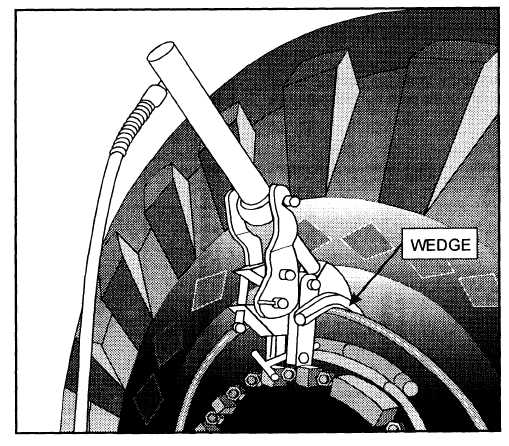the primary clamping screw firmly by hand. When the
clamping device is secured in place, turn the handle on
the bottom of the reaction screw. This handle swivels up
and down to permit maximum movement of the
clamping device side arms to ease hooking the ram
cylinder into place.
The hydraulic cylinder and shoe assembly (fig.
3-35) are actuated by a pump. The pump applies
hydraulic pressure that forces the ram with the attached
shoe down between the rim flange and tire bead. This
action separates the tire bead and rim.
When securing the ram to the clamping device,
place the ram and shoe assembly between the arms of
the clamping device where the bracket of the cylinder is
secured into the notches of the clamping device side
arms, as shown in figure 3-35.
Applying pressure to the hydraulic cylinder forces
the shoe down over the clamping device, as shown in
figure 3-35. The jaws of the clamping device acts as a
guide for the shoe. The convex side of the shoe bears
against the sidewall of the tire, forcing it inward between
the tire bead and rim flange, thus breaking loose the bead
from the rim.
Figure 3-36 shows how the wedges are placed on
each side of the shoe assembly to hold the bead of the
tire away from the rim flange so that the shoe assembly
can be easily removed. After the shoe has been forced
between the tire bead and rim flange and freed from that
portion of the tire bead, the wedges are inserted to keep
the tire bead separated from the rim. Pressure is then
removed from the hydraulic cylinder slowly. The
hydraulic cylinder and clamping device are then
removed from the rim and the clamping device is placed
approximately 90 degrees from the wedge. This process
is continued until the tire bead is completely free from
the rim flange.
Cold Patches
Cold patches are used to repair punctures and small
breaks or holes in tubes. The procedure for applying a
cold patch is accomplished by the following steps:
Figure 3-36.—Operation of hydraulic cylinder and shoe.
3-19

